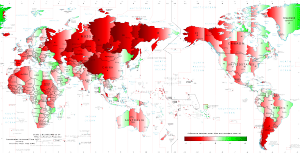Stefano Maggiolo explains a number of the issues involved with local time, solar time and standard clock time in The Poor Man’s Math Blog, and he created this map that highlights the areas where standard time leads solar time (green) and where it lags (red).
 Until mechanical clocks and faster transportation became more common in the early 19th Century, local time based around noon, when the Sun was at its highest point in the sky, was all that mattered. (click map for larger image.)
Until mechanical clocks and faster transportation became more common in the early 19th Century, local time based around noon, when the Sun was at its highest point in the sky, was all that mattered. (click map for larger image.)
For reasons Maggiolo explains, local noon varies based on latitude and time of year. Once instantaneous communication connected localities, via telegraph at first, and soon after railway schedules, a standardized time was increasingly important. Maggiolo goes into this in brief but interesting detail.
Looking at the map, I wonder why there is so much dark red near the poles (having the sun come up later makes less difference when winter is nearly all dark and summer is nearly all light) and in China (officially, it turns out, China has only one time zone across its vast expanse).
I’ve almost always lived near the center of time zones, but have noticed that the texture of life changes when the sun comes up earlier or later. Despite our efforts to tame time, its inexorable rhythms shape our experience in often unconscious ways.
This map helps visualize at least one of those.
